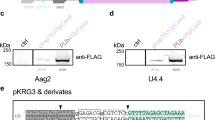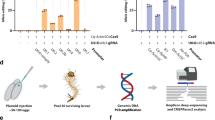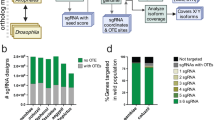Abstract
The ability to manipulate the mosquito genome through germ-line transformation provides us with a powerful tool for investigating gene structure and function. It is also a valuable method for the development of novel approaches to combating the spread of mosquito-vectored diseases. To date, germ-line transformation has been demonstrated in several mosquito species. Transgenes are introduced into pre-blastocyst mosquito embryos using microinjection techniques that take a few hours, and progeny are screened for the presence of a marker gene. The microinjection protocol presented here can be applied to most mosquitoes and contains several improvements over other published methods that increase the survival of injected embryos and, therefore, the number of transformants. Transgenic lines can be established in approximately 1 month using this technique.
This is a preview of subscription content, access via your institution
Access options
Subscribe to this journal
Receive 12 print issues and online access
$259.00 per year
only $21.58 per issue
Buy this article
- Purchase on Springer Link
- Instant access to full article PDF
Prices may be subject to local taxes which are calculated during checkout




Similar content being viewed by others
References
Morris, A.C. in The Molecular Biology of Insect Vectors of Disease (eds. Crampton, J.M., Beard, C.B. & Louis, C.) 423–429 (Chapman & Hall, London, 1997).
Grossman, G.L. et al. Germline transformation of the malaria vector, Anopheles gambiae, with the piggyBac transposable element. Insect Mol. Biol. 10, 597–604 (2001).
Catteruccia, F. et al. Stable germline transformation of the malaria mosquito Anopheles stephensi. Nature 405, 959–962 (2000).
Nolan, T., Bower, T.M., Brown, A.E., Crisanti, A. & Catteruccia, F. piggyBac-mediated germline transformation of the malaria mosquito Anopheles stephensi using the red fluorescent protein dsRED as a selectable marker. J. Biol. Chem. 277, 8759–8762 (2002).
Lobo, N.F., Hua-Van, A., Li, X., Nolen, B.M. & Fraser, M.J., Jr. Germ line transformation of the yellow fever mosquito, Aedes aegypti, mediated by transpositional insertion of a piggyBac vector. Insect Mol. Biol. 11, 133–139 (2002).
Coates, C.J., Jasinskiene, N., Miyashiro, L. & James, A.A. Mariner transposition and transformation of the yellow fever mosquito, Aedes aegypti. Proc. Natl Acad. Sci. USA 95, 3748–3751 (1998).
Perera, O.P., Harrell, II R.A. & Handler, A.M. Germ-line transformation of the South American malaria vector, Anopheles albimanus, with a piggyBac/EGFP transposon vector is routine and highly efficient. Insect Mol. Biol. 11, 291–297 (2002).
Allen, M.L., O'Brochta, D.A., Atkinson, P.W. & Levesque, C.S. Stable, germ-line transformation of Culex quinquefasciatus (Diptera: Culicidae). J. Med. Entomol. 38, 701–710 (2001).
Fraser, M.J., Ciszczon, T., Elick, T. & Bauser, C. Precise excision of TTAA-specific lepidopteran transposons piggyBac (IFP2) and tagalong (TFP3) from the baculovirus genome in cell lines from two species of Lepidoptera. Insect Mol. Biol. 5, 141–151 (1996).
Jasinskiene, N. et al. Stable transformation of the yellow fever mosquito, Aedes aegypti, with the Hermes element from the housefly. Proc. Natl Acad. Sci. USA 95, 3743–3747 (1998).
O'Brochta, D.A. et al. Gene vector and transposable element behavior in mosquitoes. J. Exp. Biol. 206, 3823–3834 (2003).
Berghammer, A.J., Klingler, M. & Wimmer, E.A. A universal marker for transgenic insects. Nature 402, 370–371 (1999).
Adelman, Z.N., Jasinskiene, N. & James, A.A. Development and applications of transgenesis in the yellow fever mosquito, Aedes aegypti. Mol. Biochem. Parasitol. 121, 1–10 (2002).
Riehle, M.A., Srinivasan, P., Moreira, C.K. & Jacobs-Lorena, M. Towards genetic manipulation of wild mosquito populations to combat malaria: advances and challenges. J. Exp. Biol. 206, 3809–3816 (2003).
Horn, C. & Wimmer, E.A. A versatile vector set for animal transgenesis. Dev. Genes Evol. 210, 630–637 (2000).
Shin, S.W., Kokoza, V.A. & Raikhel, A.S. Transgenesis and reverse genetics of mosquito innate immunity. J. Exp. Biol. 206, 3835–3843 (2003).
Franz, A.W. et al. Engineering RNA interference-based resistance to dengue virus type 2 in genetically modified Aedes aegypti. Proc. Natl Acad. Sci. USA 103, 4198–4203 (2006).
Ito, J., Ghosh, A., Moreira, L.A., Wimmer, E.A. & Jacobs-Lorena, M. Transgenic anopheline mosquitoes impaired in transmission of a malaria parasite. Nature 417, 452–455 (2002).
Travanty, E.A. et al. Using RNA interference to develop dengue virus resistance in genetically modified Aedes aegypti. Insect Biochem. Mol. Biol. 34, 607–613 (2004).
Brown, A.E. & Catteruccia, F. Toward silencing the burden of malaria: progress and prospects for RNAi-based approaches. Biotechniques 40, Suppl: 38–44 (2006).
Sanchez-Vargas, I. et al. RNA interference, arthropod-borne viruses, and mosquitoes. Virus Res. 102, 65–74 (2004).
Ito, K., Sass, H., Urban, J., Hofbauer, A. & Schneuwly, S. GAL4-responsive UAS-tau as a tool for studying the anatomy and development of the Drosophila central nervous system. Cell Tissue Res. 290, 1–10 (1997).
O'Kane, C. & Gehring, W.J. Detection in situ of genomic regulatory elements in Drosophila. Proc. Natl Acad. Sci. USA 84, 9123–9127 (1987).
Catteruccia, F., Benton, J.P. & Crisanti, A. An Anopheles transgenic sexing strain for vector control. Nature Biotechnol. 23, 1414–1417 (2005).
Marrelli, M.T., Moreira, C.K., Kelly, D., Alphey, L. & Jacobs-Lorena, M. Mosquito transgenesis: what is the fitness cost? Trends Parasitol. 22, 197–202 (2006).
Catteruccia, F., Godfray, H.C. & Crisanti, A. Impact of genetic manipulation on the fitness of Anopheles stephensi mosquitoes. Science 299, 1225–1227 (2003).
Moreira, L.A., Wang, J., Collins, F.H. & Jacobs-Lorena, M. Fitness of anopheline mosquitoes expressing transgenes that inhibit Plasmodium development. Genetics 166, 1337–1341 (2004).
Zhong, D. et al. Dynamics of gene introgression in the African malaria vector Anopheles gambiae. Genetics 172, 2359–2365 (2006).
Menge, D.M. et al. Fitness consequences of Anopheles gambiae population hybridization. Malar. J. 4, 44 (2005).
Rasgon, J.L. & Gould, F. Transposable element insertion location bias and the dynamics of gene drive in mosquito populations. Insect Mol. Biol. 14, 493–500 (2005).
Li, J. Simple mathematical models for interacting wild and transgenic mosquito populations. Math. Biosci. 189, 39–59 (2004).
Thomas, D.D., Donnelly, C.A., Wood, R.J. & Alphey, L.S. Insect population control using a dominant, repressible, lethal genetic system. Science 287, 2474–2476 (2000).
Sambrook, J., Fritsch, E.F. & Maniatis, T. in Molecular Cloning: A Laboratory Manual 2nd edn. (eds. Ford, N., Nolan, C. & Ferguson, M.) 1.42–1.50 (Cold Spring Harbor Laboratory Press, Cold Spring Harbor, New York, 1989).
Munstermann, L.E. in The Molecular Biology of Insect Vectors of Disease (eds. Crampton, J.M., Beard, C.B. & Louis, C.) 13–20 (Chapman & Hall, London, 1997).
Benedict, M.Q. in The Molecular Biology of Insect Vectors of Disease (eds. Crampton, J.M., Beard, C.B. & Louis, C.) 3–12 (Chapman & Hall, London, 1997).
Southern, E. Southern blotting. Nature Protocols 1, 518–525 (2006).
Ochman, H., Gerber, A.S. & Hartl, D.L. Genetic applications of an inverse polymerase chain reaction. Genetics 120, 621–623 (1988).
Acknowledgements
The authors would like to thank Sandi Kennedy for help in preparing the manuscript.
Author information
Authors and Affiliations
Corresponding author
Ethics declarations
Competing interests
The authors declare no competing financial interests.
Rights and permissions
About this article
Cite this article
Lobo, N., Clayton, J., Fraser, M. et al. High efficiency germ-line transformation of mosquitoes. Nat Protoc 1, 1312–1317 (2006). https://doi.org/10.1038/nprot.2006.221
Published:
Issue Date:
DOI: https://doi.org/10.1038/nprot.2006.221
This article is cited by
-
A DBHS family member regulates male determination in the filariasis vector Armigeres subalbatus
Nature Communications (2023)
-
The pupal moulting fluid has evolved social functions in ants
Nature (2022)
-
Transgenic refractory Aedes aegypti lines are resistant to multiple serotypes of dengue virus
Scientific Reports (2021)
-
Functional analysis of the promoter of an early zygotic gene KLC2 in Aedes aegypti
Parasites & Vectors (2018)
-
Synthetic miRNAs induce dual arboviral-resistance phenotypes in the vector mosquito Aedes aegypti
Communications Biology (2018)
Comments
By submitting a comment you agree to abide by our Terms and Community Guidelines. If you find something abusive or that does not comply with our terms or guidelines please flag it as inappropriate.



